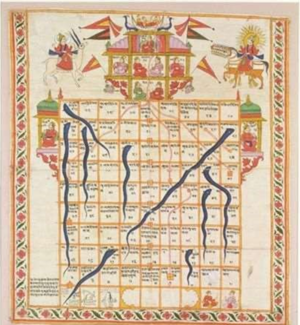Talk:Indoor Sports:Board Games
By Vishal Agarwal and The Hindu Society of Minnesota
These indoor games involving dice have been a part of Indian culture for several thousand years. Dice that perfectly resemble modern dice have been unearthed from a location named Rakhigarhi and have been dated to approximately 2500 BCE. The picture below is of these dice.
Several board games originated in India. Many games, such as Parcheesi are from India. European board games such as Ludo and Pollyanna are derived from Parcheesi.
A popular board game called Snakes and Ladders was invented by the teenager saint Jñāneśvara. He named it "Mokṣa Patham" in the early 13th century to teach good and bad values to students. Used in schools to teach the doctrine of karm, the last square was called mokṣa (salvation). Snakes represented bad behaviors (e.g., greed), and ladders were virtues (e.g., honesty).


